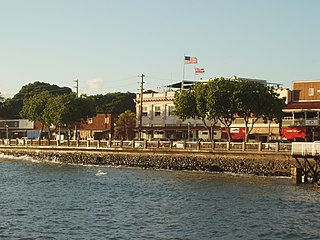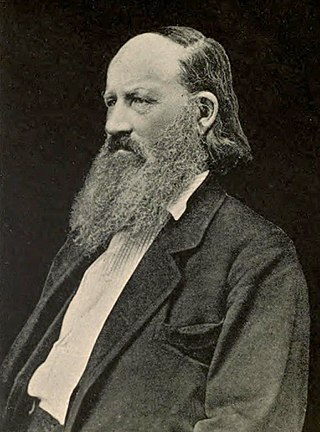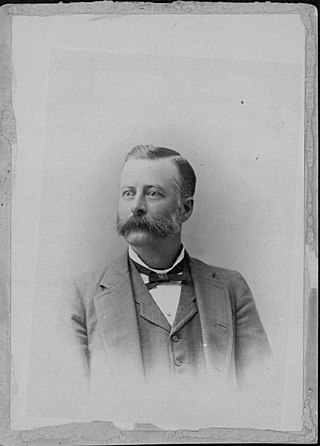Related Research Articles

Lahaina is a census-designated place (CDP) in Maui County, Hawaii, United States. On the northwest coast of the island of Maui, it encompasses Lahaina town and the Kaanapali and Kapalua beach resorts. As of the 2020 census, Lahaina had a resident population of 12,702. The CDP spans the coast along Hawaii Route 30 from a tunnel at the south end, through Olowalu, and to the CDPs of Kaanapali and Napili-Honokowai to the north.

William Pitt Leleiohoku II, born Kalahoʻolewa, was a prince of the Hawaiian Kingdom and member of the reigning House of Kalākaua.

Abraham Fornander was a Swedish-born emigrant who became an important journalist, judge, and ethnologist in Hawaii.

Kingfisher was an extreme clipper built in 1853 that sailed on the San Francisco route as well as to Hawaii on its way to China. It eventually sailed out of Uruguay. She was one of the longest lived clipper ships, with a sailing life of 36 years and 5 months. A sailing card advertised her.

Edward Preston was a lawyer and judge originally from England who served in the Kingdom of Hawaii.

Henry Martyn Whitney was an early journalist in the Kingdom of Hawaii. Born of early missionaries, he became the first postmaster and founded several long-lasting newspapers.

John Harris Soper (1846–1944) was Marshal of the Kingdom of Hawaii during the period of 1884-86 and 1888-90. He was born November 17, 1846, in Plymouth, Devon, England to Thomas Harris Soper and Mary Kipling Soper. A military man, he became Commander-in-chief of military forces of the Provisional Government of Hawaii in 1893; Adjutant General and Chief of Staff during the period of 1894-1907; and retired as Brigadier General of the National Guard of Hawaii in 1907, having previously served in the California National Guard. Also a businessman, he was President of Hawaiian News Company in Honolulu; and also managed Soper, Wright & Company, a sugar plantation, on ʻŌʻōkala, Hawaii. He served as honorary vice-president of the Societe des Sauveteurs du Dernier Adieu; and was a member of the Hawaiian Lodge No. 21, F. & A. M. Soper married Mary Elizabeth Wundenberg at Vallejo, California, in 1871; they had five children.
The following is a timeline of the history of the city of Honolulu, on Oahu, in the U.S. state of Hawaii.
Portuguese immigration to Hawaii began in 1878 when laborers from Madeira and the Azores migrated there to work in the sugarcane plantations. By the end of 1911, nearly 16,000 Portuguese immigrants had arrived.

The first bank established in the Kingdom of Hawaii was Bishop & Co., founded by Charles Reed Bishop and William A. Aldrich in 1858. Almost 25 years later, Spreckels & Co. was founded by Claus Spreckels in partnership with William G. Irwin in 1884. The Kingdom opened the Hawaiian Postal Savings Bank on July 1, 1886. By 1895 the Yokohama Specie Bank opened a branch in Honolulu and the merchant importer/exporter Hackfeld & Co. went into banking. Following the annexation of Hawaii in July 1898, plans were set in motion to establish the First American Bank of Hawaii backed by investors in New York and California. A prospectus soliciting stock subscriptions was released on May 8, 1899, and the bank opened for business on September 5, 1899. The founding board of directors included Cecil Brown (President), B.F. Dillingham (Vice-President), M.P. Robinson, Bruce Cartwright, and G.W. Macfarlane. Additional officers included W.G. Cooper (Cashier), E.M. Boyd (Secretary), and George F. McLeod (Auditor). The expressed purpose for founding the bank was to eventually convert it into a National Bank under the National Bank Act. On April 30, 1900 a special act of Congress extended the National Banking Act to include the Territory of Hawaii.

Cecil Brown was an American attorney, politician, businessman, and banker in the Kingdom, Republic, and Territory of Hawaii.

Colonel John Dominis Kauikeaouli Holt II was an official holding the rank of major and colonel within the Hawaiian Kingdom. After the American annexation of Hawaii, he became an early member of the Democratic Party of Hawaii.

Robert Hoapili Kekaipukaʻala Baker was a Hawaiian ali'i (noble), military officer, courtier, and politician who served many political posts in the Kingdom of Hawaii, including Governor of Maui, Privy Councillor and aide-de-camp to King Kalākaua.
Thomas Wright Everett was an early American resident of the Kingdom of Hawaii who served as the last Governor of Maui from 1892 to 1893.

The 1881 world tour of King Kalākaua of the Hawaiian Kingdom was his attempt to save the Hawaiian culture and population from extinction by importing a labor force from Asia-Pacific nations. His efforts brought the small island nation to the attention of world leaders, but sparked rumors that the kingdom was for sale. Critics in Hawaii believed the labor negotiations were just an excuse to see the world. The 281-day trip gave Kalākaua the distinction of being the first monarch to circumnavigate the globe; his 1874 travels had made him the first reigning monarch to visit the United States and the first honoree of a state dinner at the White House.

Sovereignty Restoration Day is a national holiday of the former Hawaiian Kingdom celebrated on July 31 and still commemorated by Native Hawaiians in the state of Hawaii. It honors the restoration of sovereignty to the kingdom, following the occupation of Hawaiʻi by Great Britain during the 1843 Paulet Affair, by British Rear-Admiral Richard Darton Thomas and when King Kamehameha III uttered the phrase: Ua Mau ke Ea o ka ʻĀina i ka Pono.

Hawaiian Independence Day was a national holiday celebrated annually on November 28 to commemorate the signing of Anglo-Franco Proclamation of 1843, the official diplomatic recognition of the independence and sovereignty of the Hawaiian Kingdom by Great Britain and France. It is still celebrated today by proponents of the Hawaiian sovereignty movement.

Kalākaua was the last king and penultimate monarch of the Kingdom of Hawaiʻi. The inherited position of the kingdom's monarch became a legislatively elected office with Lunalilo. Upon Lunalilo's death, Kalākaua won election over his political opponent Queen Emma. He reigned from February 12, 1874, until his death in San Francisco, California, on January 20, 1891.

Following the January 20, 1891 death of King Kalākaua in San Francisco, his embalmed body arrived at Honolulu Harbor aboard the USS Charleston, draped in black with its ensigns at half mast. His sister Liliʻuokalani was designated his successor.

The Privy Council of State of the Kingdom of Hawaii was a constitutionally-created body purposed to advise and consent to acts made by the monarch. The cabinet ministers were ex-officio members. Both the cabinet and other privy counselors were appointed and dismissed by the monarch according to his personal wishes. The 1887 Constitution of the Kingdom of Hawaii made a key change in regards to the cabinet ministers. The monarch was still empowered to appoint the ministers, but only the legislature, or a voluntary resignation, could remove them from office.
References
- ↑ Paradise of the Pacific. Vol. 19–22 (Public domain ed.). Honolulu, H.T.U.S.A.: Press Pub. Co. April 1906. pp. 37–. Retrieved 11 December 2011.
- ↑ Siddall, John William (1917). Men of Hawaii: being a biographical reference library, complete and authentic, of the men of note and substantial achievement in the Hawaiian Islands (Public domain ed.). Honolulu Star-Bulletin. pp. 247–. Retrieved 11 December 2011.
- ↑ Thrum, Thomas George (1930). The Hawaiian annual for ... Thos. G. Thrum. p. 46. Retrieved 11 December 2011.